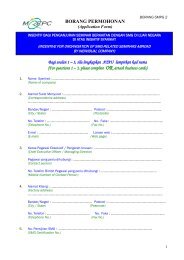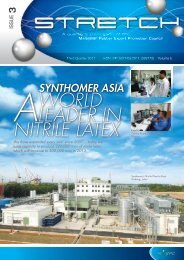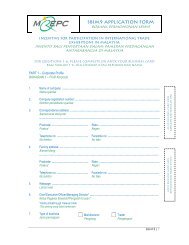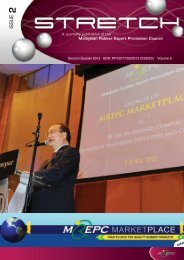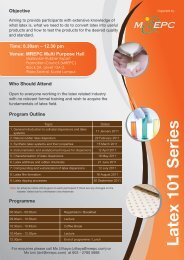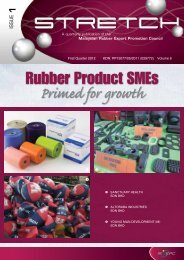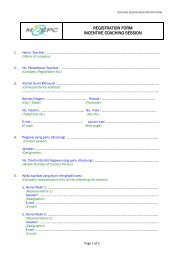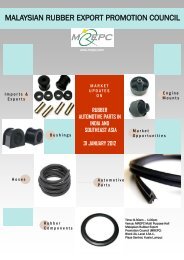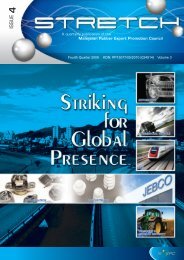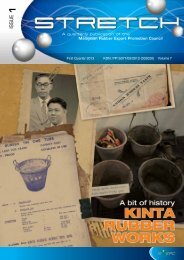Trade Fairs/Exhibitions - Mrepc.com
Trade Fairs/Exhibitions - Mrepc.com
Trade Fairs/Exhibitions - Mrepc.com
Create successful ePaper yourself
Turn your PDF publications into a flip-book with our unique Google optimized e-Paper software.
COMMENTARY<br />
<strong>Trade</strong><br />
Tips<br />
Fair<br />
-Staffing Your Booth<br />
Booth personnel are the lifeblood of your exhibit<br />
strategy. Without dynamic trade show staffing,<br />
your pre-event marketing activities, eyecatching<br />
exhibit, excellent signage, product<br />
demonstrations, and high-appeal giveaways may be<br />
wasted. During exhibitions, booth representatives not only<br />
personify your product's quality and image but also carry<br />
the responsibility for pre-qualifying your exhibit visitors<br />
and establishing relationships that convert prospects into<br />
leads and then into buyers.<br />
It goes without saying that booth personnel must be<br />
friendly, lively, and fully engaged in achieving your<br />
<strong>com</strong>pany's goals. They should be the <strong>com</strong>pany's best and<br />
the brightest representatives – those who deeply believe<br />
in the product, have superior <strong>com</strong>munication and<br />
customer service skills, and fully understand the<br />
<strong>com</strong>pany's objectives. In other words, the effectiveness<br />
of an exhibit team can make or break the success at any<br />
given show.<br />
The following are some broad guidelines for effective<br />
trade show staffing.<br />
1. Training for trade show staffing should include<br />
i. A well-practised script – Companies need to<br />
develop a thirty-second script or “elevator<br />
speech” where visitors are greeted professionally<br />
yet quickly; staffers introduce themselves and<br />
then proceed to describe the <strong>com</strong>pany's product<br />
features and benefits. Everyone should rehearse<br />
it so that all team members can consistently,<br />
effectively and effortlessly talk about the product,<br />
explain how it helps and serves users, and<br />
discuss why it is better than others available on<br />
the market today. Questions should be designed<br />
to assist staff to determine if the visitors are good<br />
prospects and enable staff to gain<br />
<strong>com</strong>prehensive visitor information for effective<br />
follow-up after the event. This could be achieved<br />
ii.<br />
by developing creative, specific, open-ended<br />
questions which would accelerate the<br />
conversation and lead to the discovery of a<br />
deeper connection or <strong>com</strong>mon point of interest.<br />
Generic questions like “How are you” should<br />
be avoided to prevent receiving canned answer<br />
like, “F.I.N.E” which also stands for “Feelings I'm<br />
Not Expressing”.<br />
How to properly qualify a potential customer who<br />
shows interest, so that time could be spent on<br />
visitors that are most likely to produce results.<br />
iii. How to give a proper demonstration of the<br />
<strong>com</strong>pany's product. Companies need to<br />
REMEMBER to take into consideration the<br />
cultural sensitivities, political climate and<br />
business peculiarities of each region/country<br />
when developing the script.<br />
2. A simple and quick way for the staff to generate<br />
leads, such as a badge scanner or guest book, should<br />
be used so that time could be spent on productive<br />
discussions with the visitors. Booth staff should be<br />
trained to encourage all visitors to either sign the<br />
book or scan their badges. Collect business cards<br />
from visitors most likely to produce results to<br />
minimize confusion when reviewing post-show data.<br />
Giveaways should be made contingent on visitors<br />
giving their business cards.<br />
3. Prepare <strong>com</strong>prehensive information for trade show<br />
personnel on what will be expected of them. This<br />
includes<br />
i. How to dress – Attire is something that<br />
differs from organization to organization. Some<br />
<strong>com</strong>panies have corporate apparel (e.g., polo<br />
shirts, sport coats, dress shirts) while others give<br />
employees some direction on personal attire with<br />
colours and clothing style. Attire should, however,<br />
18



